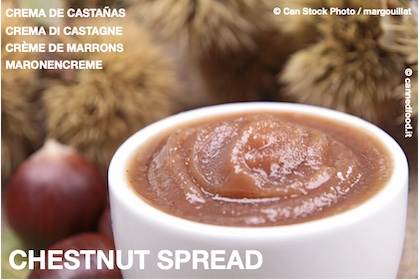
The production of chestnut spread, also known as chestnut cream or *crème de marrons*, involves several steps, each aimed at enhancing the natural sweetness and smooth texture of chestnuts. Here's a breakdown of the typical process for making chestnut spread:
1. Harvesting and Selection of Chestnuts
The process begins with selecting high-quality chestnuts, usually varieties known for their sweetness and smooth texture, such as the **"Châtaigne d'Ardèche"** or **"Marron du Tarn"**.The chestnuts are typically harvested in the autumn.
2. Boiling or Roasting
Chestnuts are either **boiled** or **roasted** to soften them and bring out their natural flavors.Roasting tends to enhance the flavor, while boiling ensures the chestnuts are soft and easy to peel.
3. Peeling
After cooking, the chestnuts are peeled to remove both the outer shell and the inner skin (which can be bitter).
This step requires care, as chestnuts can be tricky to peel, especially when they are freshly cooked. Some producers use special machines to facilitate this process.
4. Pureeing
The peeled chestnuts are then pureed or mashed to create a smooth texture. This is done by blending the chestnuts into a fine paste.
In some cases, the chestnuts are passed through a
milling machine to ensure they become as smooth as possible, removing any remaining chunks or rough bits.
5. Adding Sugar and Other Ingredients
The chestnut puree is then sweetened with sugar or honey to balance the natural taste. Some producers might use a small amount of vanilla or rum to enhance the flavor.
The sweetness varies depending on the desired consistency and taste of the final product.
6. Cooking the Mixture
The chestnut paste is gently cooked with sugar to thicken and blend the ingredients together. This step helps develop the rich, smooth texture of the spread.
The mixture is often cooked until it reaches a specific consistency, ensuring it can be easily spread but still holds its shape when served.
7. Cooling and Packaging
Once the chestnut spread reaches the desired texture, it is cooled and packaged in jars or containers for sale.At this point, the spread is often sealed to ensure freshness.
Optional Variations:
Chestnut spread with chocolate: Some versions include cocoa or dark chocolate for a richer, more indulgent taste.
Some producers incorporate spices like cinnamon or orange zest for a unique flavor twist.
Storage:
Chestnut spread should be stored in a cool, dry place. Once opened, it is typically kept refrigerated and consumed within a few weeks.
This method results in a creamy, naturally sweet spread that can be used as a topping for bread, pastries, or as an ingredient in desserts. Chestnut cream is especially popular in regions where chestnuts are abundant, such as southern France, Italy, and parts of Spain.

